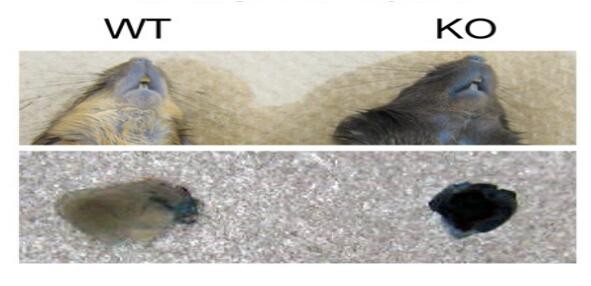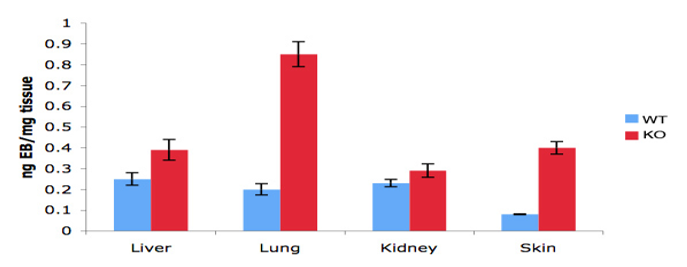The vascular barrier maintains a certain permeability, which allows essential small molecules such as ions, nutrients and water to flow toward and from tissues. This function plays an important role in ensuring cell survival, tissue function and homeostasis. And the vascular permeability is finely regulated when the endothelium need to allow larger elements such as the components of the immune system to access the tissue and heal it in the case of an injury. Vascular permeability is an essential characteristic of the vascular system. Many methods have been developed to study the vascular permeability. Here, Creative Bioarray establish an In Vivo method to measure vessel permeability using a mouse model, which makes it possible to explore the mechanisms that cause the permeable changes of blood vessel.
 Figure 1. Evens Blue extravasation in tissues following tail vein injection
Figure 1. Evens Blue extravasation in tissues following tail vein injection
The vascular permeability assay In Vivo at Creative Bioarray, also known as Miles assay, is a well-established method to determine vascular permeability In Vivo. This method is based on the intravenous injection of Evans Blue, which is a dye with high affinity for albumin in mouse models. Under physiological conditions, albumin does not cross the endothelial barrier and Evan Blue bound albumin restricted within blood vessels. In pathologic conditions that promote increased vascular permeability, endothelial cells partially lose their close contacts and the endothelium becomes permeable to small proteins such as albumin. Thus, since blood vessels start to leak protein and also the Evans Blue that is bound to albumin, Evans Blue will appear in the organs with increased permeability. Whereas, a healthy endothelium prevents the Evans Blue crossing the blood vessels and accumulating in organs. Organs with increased permeability will show significantly increased blue coloration compared to organs with intact endothelium. The extent of vascular permeability can be quantified by simple visualization or by quantitative measurement of the dye incorporated of the tissue or animal.
 Figure 2. Quantitation of Evens Blue extravasation in different tissues
Figure 2. Quantitation of Evens Blue extravasation in different tissues
The simplicity and quantitative characteristics of this method makes it a great advantage over other permeability assays. This assay is also a powerful and versatile method to determine the effect of different compounds on vascular permeability. The results of this assay can be accompanied by molecular studies, which lead a further understanding of vascular permeability.

Online Inquiry